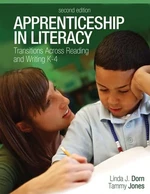Grounded in social and cognitive learning theories, the second edition of Apprenticeship in Literacy: Transitions Across Reading and Writing, K-4 still details the seven principles of apprenticeship learning and helps Kâ4 teachers implement and assess guided reading, assisted writing, literature discussion groups, word study lessons, and literacy centers across an integrated curriculum. The new edition also features the following: Updated research emphasizing the importance of early reading as a road map for success Information on how behaviors, from emergent to fluent, align to the Common Core State Standards Dozens of new classroom examplesâstudents' work, photographs, transcripts, teacher-student conferences, and reproducible resources Language prompts that promote self-regulated learners Schedules for implementing a workshop framework in whole-group, small-group, and one-to-one settings Suggestions for incorporating information texts into a balanced literacy program Stronger emphasis on the importance of the writing process Additional ideas on establishing routines and organizing the classroom The theme of apprenticeship in literacy resonates throughout the book: children learn from teachers and teachers learn from one another as they promote children's transfer of knowledge across multiple contexts. The final chapter provides real-world examples of teachers working together to ensure that all children become literate. Since its original publication in 1998, Apprenticeship in Literacy has become a teacher favorite, covering all aspects of a balanced literacy program in an integrated manner and showing how all components are differentiated to address the needs of diverse learners. An apprenticeship approach to literacy emphasizes the role of the teacher in providing demonstrations, engaging children, monitoring their understanding, providing timely support, and ultimately withdrawing that support as the child gains independence.
Price history
Oct 25, 2021
€32.03

